Company car tax and Vehicle Excise Duty (VED) will continue to be based on CO2 values from the existing emissions test rather than a new ‘real-world’ regime, when the test is introduced from September.
HM Treasury (HMT) told Fleet News that both the CO2 values obtained via the New European Driving Cycle (NEDC) and its replacement, the Worldwide harmonised Light vehicles Test Procedure (WLTP), will continue to be recorded for “the next few years”.
“HMT’s preferred approach is to work with the industry over a coordinated approach to informing customers of the meaning of the new test cycle, and the differences between WLTP and NEDC values,” said a Treasury spokesman.
“We will look to agree a suitable moment to move the tax system from NEDC to WLTP, based on industry input, but we are not looking to do this with effect from September this year.”
An NEDC value on new cars will be determined by a complex formula, which will allow an NEDC measurement to be calculated from the new WLTP result.
Fleets had feared WLTP would initially create a two-tier tax regime, with new cars having a significantly higher CO2 value under the new test compared to existing models tested under the NEDC regime.
Then, when all cars have to be issued with WLTP data from September 2018, everybody would fall under the new regime, with all employers and employees potentially facing a substantial rise in tax.
Experts have suggested that the increase in CO2, as a result of the new testing regime, could be anywhere between 10% and 20%, affecting benefit-in-kind tax (BIK) rates, VED and capital allowances/lease rental restrictions.
Andy Eastlake, managing director of Low Carbon Vehicle Partnership (LowCVP), told a technical and operational management forum organised by the British Vehicle Rental and Leasing Association (BVRLA): “I expect we will continue with NEDC CO2 numbers for some considerable time.
“Company car tax is defined until 2021 and all of those are based on NEDC numbers, so, before we change, we’ve got to go through a significant discussion about what the implications are. That gives us an opportunity to get data from the new cycle, understand it and then define the categories and the thresholds in an appropriate way.”
However, he acknowledged that what the fleet and leasing industry sees as ‘appropriate’ may be different to the Treasury.
The Government says one of the reasons it will continue to publish an NEDC CO2 value is to ensure that manufacturers can comply with the 2020 emissions targets set by the European Commission.
It set an average emissions target of 95g/km of CO2 for cars and 147g/km for vans, which will also be tested under the new regime, by the end of the decade.
It is therefore hoped they will also maintain this focus on NEDC values for company car tax, with BIK brackets published up until 2021.
However, the lack of clarity around how and when the results from the new testing regime will be used, and the inevitable complexity they will bring, is frustrating the leasing industry.
The BVRLA told Fleet News it is “really focused on the issue” and is meeting with Treasury officials this week to stress the need for any changes to be “well-signalled and for there to be a smooth transition”.
Speaking at the recent BVRLA forum, Simon Healey, pricing forecasting manager for Lex Autolease, said: “We need somebody to stand-up and say this is exactly what’s coming and when.”
The leasing company set-up a project team 12 months ago to start looking at the issue. However, Healey added: “We have been working on assumptions, because that clarity has not been available to us.”
It has been liaising with manufacturers in order to understand what they know, what they’re going to publish and how it can work with that data. But, having raised the issue with both the Treasury and HM Revenue & Customs (HMRC), Healey said: “The feedback we have got so far has been very vague, which is a little bit disappointing.”
He continued: “Dual emission values lead to further complexity, because which number are we going to be using? Are we going to supply one number for BIK and one number for VED; are we going to be giving a dual rate to people?
“Will the back calculation from the new WLTP cycle result in a higher NEDC rate than we’ve got today and, if it does, how can we make sure we can communicate that appropriately to our customers?
“How can we make sure we can consult with them in the way that we want to drive down the emissions of their fleets appropriately as well?
“We are at a point where the complexity is still outweighing the clarity.”
Leasing companies and data suppliers face a massive task in updating IT platforms to work with the new data, along with meeting the development costs that will entail.
Healey is also concerned how optional equipment will impact a vehicle’s CO2. Under the existing regime, leasing companies’ systems can easily calculate CO2 values appropriate to a customer’s requirements. However, it is not clear yet how the new regime will factor in optional extras which have an impact on CO2 values.
“We’re potentially going to have a greater matrix and we need to make sure our systems can cope with that – the complexity of the calculation to us increases,” Healey said.
Alan Henson, head of sales and customer service at KeeResources, echoed Healey’s concerns. He said: “It will inevitably make quoting contract hire rates to customers significantly more complex.”
It has pulled together experts from its consulting, new and used vehicle data and forecasting teams to deal with the issue. However, it is also concerned that when the changes will be applied has not been clearly signposted.
Matt Freeman, WLTP specialist at Cap HPI Consulting, told the BVRLA forum: “I suspect the Treasury will be itching to move to something which generates more revenue for them as quickly as they can. But we can’t simply go from one thing to another. It’s imperative all interested parties are speaking with one voice on this.”
The LowCVP believes CO2 and fuel economy should be separated in the interim period. “Consumers don’t need them to be from the same test,” said Eastlake. “They need a CO2 number to determine how much tax they’re going to pay and a fuel economy number to show how much fuel they’re going to use.”
Eastlake argues the CO2 value can continue to be used from the NEDC test, while a more accurate fuel economy figure can be supplied via the WLTP. “There’s an argument to say that we don’t want it out there until it’s actually used for something,” he said.
“If there’s any sense in the world, I suspect the European Commission will say that the fuel economy information from the new test cycle should be made available to consumers as soon as possible, because that was one of the prime reasons for changing the test cycle.”
He believes there will be a strong lobby across Europe to try to retain the old CO2 values for taxation purposes until it can be transitioned in a managed way.
However, he concluded: “Until, they come out and say what’s coming and this is what it means to you over the next five years, it remains a major issue for the industry.”





















Login to comment
Comments
No comments have been made yet.